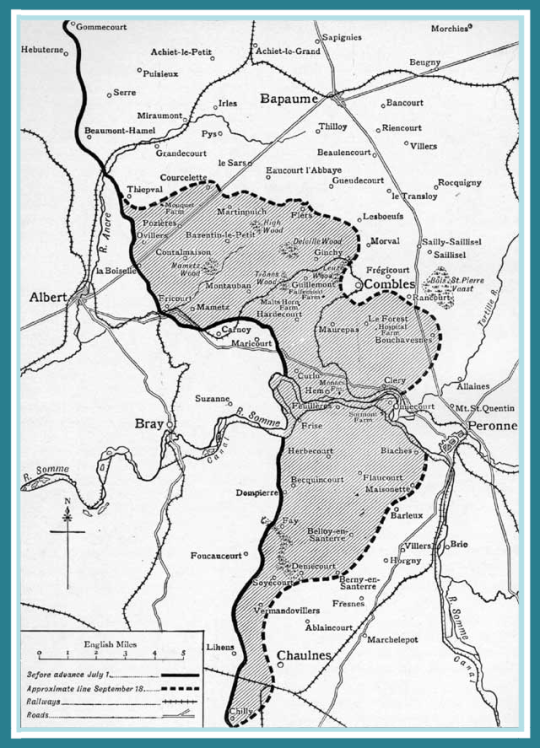
WESTERN FRONT,1916.
At the end of 1915, Sir Douglas Haig had succeeded Sir John French as Commander in Chief of the BEF and Sir William Robertson had become CIGS.
The first serious attempt to secure unity of action among the Allies took place at the Chantilly conference on 6th–8th December 1915.
Britain’s new armies wee approaching full tides. On 1st January 1916, there were nearly 1,500,000 men in the United Kingdom (second line Territorial Force Divisions) and 1,000,000 men in France. The force at the front consisted of thirty Divisions of Infantry and five of Cavalry, with a further nineteen Divisions arriving during the first six months of the year. But as Haig stated in a letter to Lord Kitchener, “I have not got an Army in France really, but a collection of divisions untrained in the field. The actual fighting Army will evolve from them.”
Yet, even then, Haig was aware that the war must be won by the forces of the British Empire; to support the French, he realised “our troops will be used up, no less”; however, he won the point with Joffre over “wearing out fights” (he was against them and the risk of unnecessarily exhausting the British Army). Joffre desired simultaneous concentric Allied offensives, but Falkenhayn, with his gaze fastened on Verdun, stole the initiative – though “with limited resources”. The main Allied (Franco- British) offensive for 1916, the great battles of the Somme, was delayed until the 1st July.
Among the New Army formations to arrive in France in mid December 1915 was 16th (Irish) Division, under Major General WB Hickle.
In its 47th Brigade were 6th Royal Irish, 6th Connaught Rangers, 7th Leinsters and 8th Munsters; 48th Brigade contained 7th Irish Rifles, 9th Munsters and 8th and 9th Dublins; while 7th and 8th Inniskillings, with 7th and 8th Irish Fusiliers made up 49th Brigade. The Division was to see its first serious action in the Halluch sector in April 1916.
By this time, the BEF contained every conceivable type of supporting arms or service, covering the Royal Flying Corps, gas (and flame) warfare, camouflage, anti aircraft, survey, electrical and mechanical units, labour battalions, motor ambulances and schools of instruction. The standard field artillery remained the 18 pounder gun and 4.5 inch howitzer, but the heavy artillery had grown considerably and indeed 60 pounder, 6 inch and 4.7 inch and howitzers up to 15 inch.
On 1st July 1916, infantry battalions had 16 light automatics (Lewis guns); the Machine Gun Corps was formed in November 1915. Great advances were made in signalling (fathered by the RE, who also formed Tunnelling Companies). The Services became increasingly important and the value of Padres in the field was recognised by the troops.
France/Flanders - January to July 1916.
France/Flanders - October to December 1916.
Irish Infantry units on the Western Front were represented in 1916 by:
1st Bttn, Irish Guards - 1st Guards Brigade, Guards Division.
2nd Bttn, Irish Guards - 2nd Guards Brigade, Guards Division.
2nd Bttn, Royal Munster Fusiliers - 3rd Infantry Brigade, 1st Division.
1st Bttn, Royal Irish Fusiliers - 10th Infantry Brigade, 4th Division.
2nd Bttn, Royal Dublin Fusiliers - 10th Infantry Brigade, 4th Division.
2nd Bttn, Royal Irish Regiment - 11th Infantry Brigade, 4th Division, moved to 22nd Infantry Brigade, 7th Division in May and then onto 49th Infantry Brigade, 16th (Irish) Division in October.
1st Bttn, Royal Irish Rifles - 25th Infantry Brigade, 8th Division.
2nd Bttn, Leinster Regiment - 73rd Infantry Brigade, 24th Division.
2nd Bttn, Royal Irish Rifles - 74th Infantry Brigade, 25th Division.
1st Bttn, Royal Dublin Fusiliers - 86th Infantry Brigade, 29th Division.
1st Bttn, Royal Inniskilling Fusiliers - 87th Infantry Brigade, 29th Division.
2nd Bttn, Royal Inniskilling Fusiliers - 96th Infantry Brigade, 32nd Division.
10th Bttn, Royal Dublin Fusiliers - 190th Infantry Brigade, 63rd (Royal Naval) Division.
16th (Irish) Division.
36th (Ulster) Division.
1/8th Bttn, King's Regiment (Liverpool Irish) - 165th Infantry Brigade, 55th (West Lancashire) Division.
1/18th Bttn,London Regiment (London Irish Rifles) - 141st Brigade, 47th (2nd London) Division.
2/18th Bttn, London Regiment (London Irish Rifles) - 180th Infantry Brigade, 60th (2/2nd London) Division, which moved to Salonika in November.
24th/25th/26th/27th Bttn, Northumberland Fusiliers (Tyneside Irish) - 103rd Infantry Brigade, 34th Division.
Source: "A History of the Irish Soldier", Brigadier AEC Bredin DSO MC DL.
